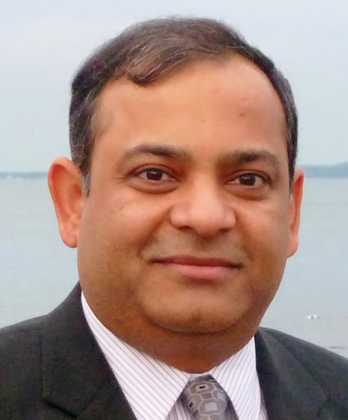It’s been almost a year since two leading industry software and technology companies—GroundWidgets and Livery Coach Solutions—announced their merger, and by all accounts, integration has been without any major snags for their teams, and, most importantly, they are working hard to minimize any customer impacts. Livery Coach Solutions is now a wholly owned subsidiary of GroundWidgets, which offers the popular SantaCruz software.
We caught up with GroundWidgets Chairman & CEO Apurva Patel and Livery Coach President David Hirsch for a behind-the-scenes discussion as these two companies continue to innovate and set benchmarks with their collective development team for new cutting-edge features across both platforms.
 David Hirsch
David Hirsch  Apurva Patel Chauffeur Driven: Why were the two companies a good fit?
Apurva Patel Chauffeur Driven: Why were the two companies a good fit?
Apurva Patel: GroundWidgets and Livery Coach have been in this industry for a very long time, and we respect each other’s products. The cost of technology development has risen exponentially but the appetite for clients to pay a premium for that technology has greatly diminished. When we started talking about working together more than a year ago, our philosophy was why do we want to build duplicative technology when we can collaborate. When we began to discuss merging the two companies together, we were both pleasantly surprised that our underlying technology and our feature sets were similar, and while we both have big development teams, we were essentially building duplicative solutions. We felt that focusing our energies toward building the next-generation platform as cooperative partners was going to move the industry forward faster than by remaining competitors. Speed to market is critical in today’s day and age.
David Hirsch: We both have long lists of customer-requested enhancements and features to complete. When we looked at coming together, we realized we were consuming our limited resources developing features that SantaCruz already had. We’re the smaller company, and it was hard to find the time to develop things like AI-based enhancements or workflow automation. Now we have a combined development team that is much larger than either of us had individually, which enables us to bring more advanced technologies to the industry faster.
CD: What are your clients looking for from their software?
AP: Clients ask if we can build something like an Uber app, but Uber spends $400 million a year on that technology. The economics don’t work.
DH: The industry historically has not supported big R&D investments. As technology developers, we look for return on investment and depend on our customers for continued support. We are now seeing clients understand the value of an investment in technology.
AP: Unfortunately, our industry has never had the appetite to spend money on technology and automation. They will spend $100,000 on a brand-new Mercedes or an SUV, because they see that vehicle as a revenue generator, but they don’t see software in the same way. However, technology helps them reduce their operating costs, or redeploy resources towards other higher value projects. By combining our resources, we’re able to spread the cost of the development across a much larger footprint of customers and make our software more affordable and scalable. We will never be able to build technology at the scale of Uber, given the capital investment that we have at our disposal, but we know that we must keep delivering great technology and come as close to as possible with the feature set. We also believe that most of our clients appreciate that we work tirelessly to build a best-in-class platform, with our limited resources, and that seems to align with their business requirements.
CD: What does the next generation platform look like to you?
AP: As we look a few years out, our goal is to take the best features and functionalities of both systems and build a common platform with higher levels of automation, artificial intelligence, and real-time data analytics and dashboards. Technology obsolescence is something that we are always very cognizant about, so we anticipate what the future is going to be and start building solutions today before our customers ask for it.
CD: Will both the Livery Coach and SantaCruz platforms continue to operate?
DH: We’ll continue to support our customers for the foreseeable future and develop and improve Livery Coach as a software product. It’s just that now we have more resources and a larger combined development team to accelerate our development.
AP: Our goal is not to phase anything out but to give clients a choice of portfolio of products that serves them best. The priority is always going to be assessing our customers’ requirements, and delivering a solution suite fit for their operations.
DH: There’s a lot of overlap in features and functions between the software, but there are some things that we think we do well, certain niches that we’re pretty good at, and there’s a lot that SantaCruz is better suited to do, depending on the type of business and size of the company.
CD: What is the status of the integration?
DH: A lot of integration so far has been behind the scenes. Our technology teams are coordinating new development, the accounting teams are merging, and our sales teams are working collaboratively. We also have completed the GroundXchange integration between the Livery Coach and SantaCruz back-office systems. Our teams get along very well as we have similar company cultures, which is about putting customers first and taking care of our employees. Nobody left, either voluntarily or involuntarily. We didn’t merge to cut costs; we did it to expand scope, and we’re going to continue to work on that.
AP: Our goal is prioritizing the projects that will give the maximum value and benefit to our mutual customers. The teams are getting to know each other and their capabilities because we have so much work ahead of us that we can’t afford to lose any resources. Our focus has always been on creating a technology platform that provides seamless connectivity and operational capabilities across the industry, where every operator essentially behaves like a branch office of each other, so that they can easily send work to each other. I often use the analogy of the FTD network where you can go to your local florist and place an order to send a bunch of roses to your mom in California. The FTD florist affiliate on the other side of the country puts together the roses and handles delivery—it’s completely seamless and frictionless. You don’t even think about how that order gets fulfilled. We want to take the ground transportation industry to that level.
CD: What would that look like?
AP: It would be an alliance model where every operator behaves in a transparent manner, where you can move reservations back and forth between the systems and easily monitor reservations, get status updates, and reduce the amount of manual work. Why is Uber able to scale? Because they have automated the heck out of everything. Our industry is getting to a point where our clients now understand that technology is a critical component of growing their business, especially since many have staffing challenges. Our mission is to be the technology enabler that allows our customers to deliver that great service coupled with technology automation. We have so many test cases where customers who were making $2 million a year in revenue came onto our platform and grew to $6 million or $7 million within two years because automation was helping them. It’s a symbiotic relationship: Let us worry about the technology automation so you (our customer) can focus on providing that high-touch, white-glove service.
CD: What are the next benchmarks for the companies?
AP: We’re putting together a roadmap for 2025. We’re looking at building more AI capabilities into the system, as well as delivering a lot of the features and enhancements that customers have been requesting. We’ll fine-tune our offerings and likely announce new products when we get to the show next year.
DH: There’s a synergy that basically will help us deliver more functionality and do it faster. It’s not like either company was broken or had major problems. It’s just that there’s a lot to do, and there’s a backlog, but this will help us move forward faster.
AP: Why do our clients stay with us? Very simple: They trust us as their technology partner. David and I both have built very deep relationships with our customers over the years, and we want to keep wowing our customers. We want to keep delivering great products, while focusing on the future, and you will see that in 2025. [CD1124]
Q&A With David Hirsch of Livery Coach Solutions and Apurva Patel of GroundWidgets
- Details

